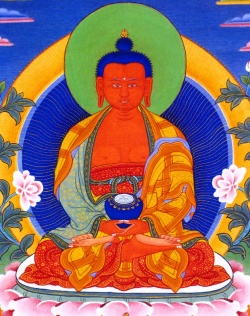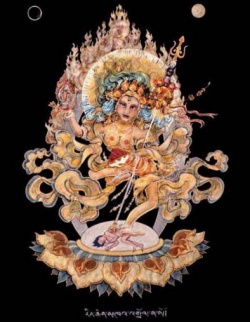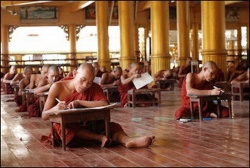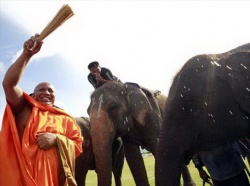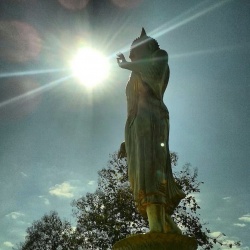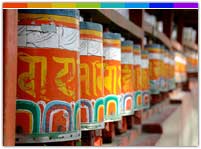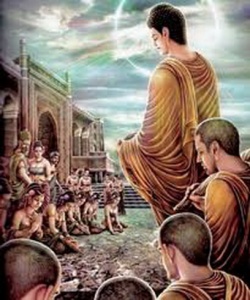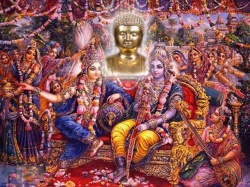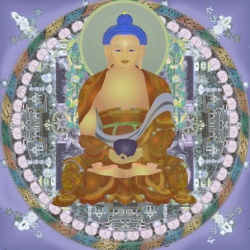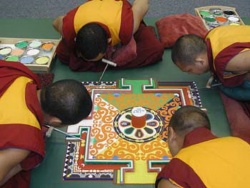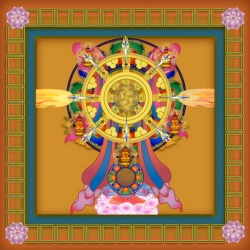Difference between revisions of "Lokottara-vāda"
| Line 1: | Line 1: | ||
| − | [[File:Amitabha.jpg|thumb|250px|]]<nomobile>{{DisplayImages|222|678|2401|1113|3753|1656}}</nomobile> | + | [[File:Amitabha.jpg|thumb|250px|]]<nomobile>{{DisplayImages|222|678|2401|1113|3753|1656}}</nomobile><nomobile>{{DisplayImages|602|3641|3382|1551|2387|561}}</nomobile> |
Latest revision as of 17:45, 1 December 2015
Lokottara-vāda (Sanskrit). ‘The Supermundane School’, also known as ‘The One-utterance School’ (Ekavyavahāra), being a subdivision of the Mahāsaṃghika which taught that a Buddha in reality is endowed with a supermundane (lokottara) nature, omniscience, limitless power, and eternal life.
It also taught the docetic doctrine that any physical manifestations or actions on earth undertaken by a Buddha are merely appearances or illusory projections performed to save beings.
Little literature remains of this school with the exception of the Mahāvastu and the Bhiksunī Vinaya, or monastic rule for nuns.
The Buddhological ideas of this school seem to have influenced the development of similar Mahāyāna concepts.
The Lokottaravāda (Sanskrit; traditional Chinese: 說出世部; pinyin: Shuō Chūshì Bù) was one of the early Buddhist schools, according to Mahāyāna doxological sources compiled by Bhavyaviveka, Vinitadeva and others, and was a sub-group which emerged from the Mahāsāṃghika sect.
Etymology
The name Lokottaravāda means those who follow the supramundane (Skt. lokottara), or transcendent, teachings.
Despite bearing this name, all sub-sects of the Mahāsāṃghikas seem to have accepted forms of supramundane or transcendent teachings.
Early history
The Śāriputraparipṛcchā and the Samayabhedoparacanacakra both suggest that the Lokottaravāda had their origins with the Ekavyāvahārikas and the Gokulika's.
While the Mahāsāṃghikas initially flourished in the region around Magadha, the Lokottaravādins are known to have flourished in the Northwest.
The 6th century CE Indian monk Paramārtha wrote that 200 years after the parinirvāṇa of the Buddha, much of the Mahāsāṃghika school moved north of Rājagṛha, and were divided over whether the Mahāyāna teachings should be incorporated formally into their Tripiṭaka.
According to this account, they split into three groups based upon the relative manner and degree to which they accepted the authority of these Mahāyāna texts.
According to Paramārtha, the Lokottaravādins accepted the Mahāyāna sūtras as the words of the Buddha (buddhavacana).
Texts
Mahāvastu
Lokottaravādin views are known from the Mahāvastu, which is a rare surviving Mahāsāṃghika text in Sanskrit.
The Mahāvastu is a biography of the Buddha which attributes itself to the Lokottaravādins, and appears to have been an extended section of their vinaya recension.
The Sanskrit text of the Mahāvastu was preserved in the libraries of the Mahāyāna Buddhists of Nepal.
Sukhāvatīvyūha influences
Some scholars believe that the Mahāyāna Longer Sukhāvatīvyūha Sūtra was compiled in the age of the Kuṣāṇa Dynasty in the 1st and 2nd centuries CE, by an order of Mahīśāsaka bhikṣus, which flourished in the Gandhāra region.
However, it is likely that the longer Sukhāvatīvyūha owes greatly to the Lokottaravāda sect as well for its compilation, and in this sūtra there are many elements in common with the Lokottaravādin Mahāvastu.
The earliest of these translations show traces of having been translated from the Gāndhārī language, a prakrit used in the Northwest.
Bamiyan monastery collection
The Chinese Buddhist monk Xuanzang visited a Lokottaravāda monastery in the 7th century CE, at Bamiyan, Afghanistan, and this monastery site has since been rediscovered by archaeologists.
Birchbark and palm leaf manuscripts of texts in this monastery's collection, including Mahāyāna sūtras, have been discovered at the site, and these are now located in the Schøyen Collection.
Some manuscripts are in the Gāndhārī language and Kharoṣṭhī script, while others are in Sanskrit written in forms of the Gupta script.
Manuscripts and fragments that have survived from this monastery's collection include the following source texts:
Pratimokṣa Vibhaṅga of the Mahāsāṃghika-Lokottaravāda (MS 2382/269)
Mahāparinirvāṇa Sūtra, a sūtra from the Āgamas (MS 2179/44)
Caṃgī Sūtra, a sūtra from the Āgamas (MS 2376)
Vajracchedikā Prajñāpāramitā Sūtra, a Mahāyāna sūtra (MS 2385)
Bhaiṣajyaguru Sūtra, a Mahāyāna sūtra (MS 2385)
Śrīmālādevī Siṃhanāda Sūtra, a Mahāyāna sūtra (MS 2378)
Pravāraṇa Sūtra, a Mahāyāna sūtra (MS 2378)
Sarvadharmapravṛttinirdeśa Sūtra, a Mahāyāna sūtra (MS 2378)
Ajātaśatrukaukṛtyavinodana Sūtra, a Mahāyāna sūtra (MS 2378)
Śāriputra Abhidharma Śāstra (MS 2375/08)
It is likely that the Lokottaravādins had no major doctrinal distinctions to distinguish them as different from Mahāsāṃghika, but that the difference was instead a geographic one. Tāranātha viewed the Ekavyāvahārikas, Lokottaravādins, and Gokulikas as being essentially the same.
He even viewed Ekavyāvahārika as being a general term for the Mahāsaṃghikas.
The earlier Samayabhedoparacanacakra of Vasumitra also regards the Ekavyāvahārikas, Gokulikas, and Lokottaravādins as being doctrinally indistinguishable.
According to Vasumitra, 48 theses were held in common by these three Mahāsāṃghika sects.
Of the 48 special theses attributed by the Samayabhedoparacanacakra to these sects, 20 points concern the supramundane nature of buddhas and bodhisattvas.
The Lokottaravādins asserted that there are no real things in the world except two kinds of emptiness (Skt. śūnyatā), that is, the emptiness of a self (Skt. pudgala-śūnyatā) and the emptiness of phenomena (Skt. dharma-śūnyatā).
This two-fold view of emptiness is also a distinguishing characteristic of Mahāyāna Buddhism.
The Buddha is viewed as transcendent (Skt. lokottara) and his life and physical manifestation are mere appearance.
The Lokottaravāda school upheld the Mahāsāṃghika view of the supramundane nature of the buddhas and bodhisattvas, and the imperfection and fallibility of arhats.
Bodhisattvas
The Lokottaravādin Mahāvastu speaks of Buddhism as consisting of the Three Vehicles, and includes specific instructions regarding the Bodhisattva Path and the practices of bodhisattvas.
From the Mahāvastu, we know that the Lokottaravādins had a conception of a bodhisattva's progress toward enlightenment as consisting of ten grounds, or bhūmis, as required for Mahāyāna bodhisattvas.
These bhūmis described in the Mahāvastu are similar to those in the Mahāyāna Daśabhūmika Sūtra, but the names of these stages seem to differ somewhat.
Buddha-fields
From the Mahāvastu, it is evident that the Lokottaravādins also held that there were innumerable buddha-fields (Skt. buddha-kṣetra), throughout which there are innumerable buddhas and innumerable tenth-ground bodhisattvas who will become buddhas.
Each is said to lead limitless sentient beings to liberation, yet the number of sentient beings is essentially infinite.
Equality of buddhas
In the Mahāvastu, there are some Lokottaravādin accounts of the nature of buddhas which have strong parallels to those in Mahāyāna sūtras.
In one section, a multitude of devas are described as putting up sunshades in honor of the Buddha, who in turn shows himself sitting beneath each and every one.
Each deva believes himself to be particularly honored, unaware of the fictitious character of his own buddha, who is no different from the others he sees.
This has a parallel with an account in the Mahāyāna Śūraṅgama Samādhi Sūtra.
In this text, the Buddha appears simultaneously on a vast number of lion-thrones prepared by various devas, but each deva sees only the buddha that is sitting on his own throne, and not the throne of others.
At the appropriate moment, all the buddhas are revealed to the devas, and one asks which is real – his own buddha, or all the others.
In the Śūraṅgama Samādhi Sūtra, the Buddha's answer is ultimately that they are all equal, because the nature of buddhas is not apart from all phenomena.
Future buddhas
In the Mahāvastu, the future buddha Maitreya is mentioned a number of times, and the text states that he will be just one of the one thousand buddhas who are destined to appear in the future following Gautama Buddha.
The Mahāsāṃghika-Lokottaravāda view is contrasted with the common view in the Theravāda tradition, which holds that five buddhas are destined to follow Gautama.
